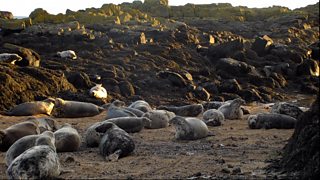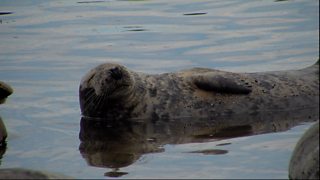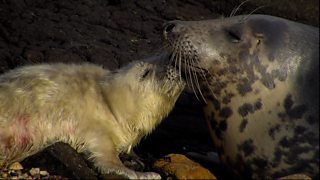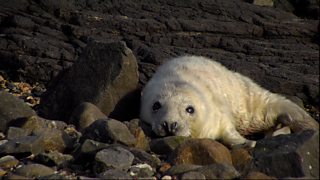By Tom Winter from the Autumnwatch digital team

There’s a global rarity occupying our shores. It’s not a fish, nor a bird, or a whale, but it is a relatively large and conspicuous marine mammal. You may have already seen one for yourself from time to time, its head bobbing above the water level like a buoy, possibly you have even seen one lay lethargically on a distant rocky beach or cliff base... Or, like me you have been watching them burp, gurgle, wriggle and cry on Autumnwatch’s Isle of May live cameras. I am of course referring to the grey seal.
The cameras on the Isle of May National Nature Reserve, run by Nature Scot, were installed earlier this year under the watchful eye of reserve rangers before the pupping and breeding seals had returned. This has allowed us to get the amazingly intimate live camera footage you may be watching whilst reading this, as 3,000 adult grey seals arrive on the island’s shores to give birth and to breed.
What am I looking for?

Given its name, you might think that a grey seal’s fur is uniformly grey, but individuals are extremely variably with fur ranging from grey to grey-brown. It is also mottled with spots and blotches, the patterns of which are unique to each individual. The fur differs on males and females, with bulls being darker with light spots, and cows lighter with dark spots
The grey seal is the larger of the two seal species found around our coast, the other being the harbour seal, and both can be seen all year round in the UK. Both grey seal and harbour seals are members of the “true seal” family Phocidae., You may also hear this family being referred as “earless seals”, due to them lacking ear flaps like their distant cousins the “eared seals” which include sea lions and fur seals.
When out of the water the differences between the two species is immediately apparent with some adult grey seals weighing as much as three times the average weight of an adult harbour seal. In the water the differences between them are more subtle, but still discernable by some key features; the most noticeable being that grey seals possess a much heavier muzzle, sometimes referred to as a ‘roman nose’ when seen in profile. This may have led to the rather unflattering scientific name with which they have been labelled - Halichoerus grypus, which roughly translates to “Hook-nosed Sea Pig”.
Why are they here?

Grey seals buck the trend when it comes to pupping and breeding. Unlike most UK mammals, grey seals choose to give birth and breed well into the autumn months. Whilst they spend most of their lives at sea, every autumn female grey seal will haul themselves up above high tide level onto rocky outcrops or sheltered beaches, sometimes the very same ones the mothers were born on. Here they will give birth to a single pup.
Mothers and pups have an immediate bond and the mothers will go without food whilst diligently guarding their pups until they are weaned. At birth, pups are between 13-15kg in weight and are easily distinguishable from a distance due to their adorable white coat, also known as a lanugo, which they will shed soon after weaning. Pups will suckle from their mother with milk which contains up to 50% fat; and as you might expect from such a calorie rich milkshake the pups grow fast - very fast. In order to counter the cold seas, within 3 week the pups will have developed a thick layer of blubber, trebling their weight. These fat reserves are also essential as the pup learns to hunt and feed for itself.
The females are not alone when they begin to pup, however. During this time male bull grey seals will return to the same beaches and rocky outcrops and compete between each other for territory. Competition can be fierce and often comes to blows, the scars of which you will likely see on dominant males. The winning combatant will gain the sole mating rights to the harem of females within his territory. Females will be ready to breed within 3 weeks of their pup’s birth; however, they possess the ability to delay implantation of the egg for up to 3 months which ensures that pups are born at around the same time each year after an 11-month gestation period.
Do not Disturb

Today it is estimated that grey seal populations are more than 120,000 in Britain alone, around 40% of the global population. With that in mind, it might surprise you to learn that globally there are fewer grey seals than there are African elephants. With such a rare seal resident on our shores our responsibility to protect them is self-evident. Grey seals are protected by law in the UK, however they are still under threat, mainly through disturbance from humans and our pets. If you come across seals out of the water, give them plenty of space and keep dogs away - this is especially true for seal mothers and pups.
You can also read a first hand account of “Life on Seal Island”, written by reserve manager, David Steel. And watch all of the action from the Isle of May live, from 11am to 11pm up until 9pm on Friday 6 November right here.
